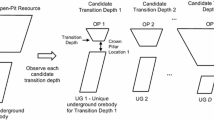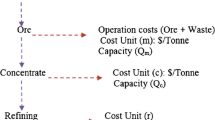Abstract
During the last few decades, open pit mines have been deepened to the remote depths of the ground such that removing great volumes of waste rocks may jeopardize their profitability. In such circumstances, an early transition from open pit to underground mining may prove more profitable. This is the case in many large-scale open pit mines, where considerable amount of mineral reserve remains beneath the pit bottom. This paper develops a set of classified integer programming models for determining an optimum transition depth (OTD) between open pit and various underground mining methods. The models lie within the scope of long-term production scheduling because the OTD is revealed through scheduling of all mineral reserve. To provide a quantitative analysis, two optimization models with distinct solution strategies are executed on a three-dimensional sector of a real orebody. The results indicate that the integrated models increase the total NPV of the mining operations by up to 8.62%. However, the scenario-based models enhance the primitive solution (the base scenario) by up to 3.42%. It is also shown that the integrated models present solutions that are practically more realistic.













Similar content being viewed by others
References
Asad, M. W. A., & Dimitrakopoulos, R. (2013). A heuristic approach to stochastic cutoff grade optimization for open pit mining complexes with multiple processing streams. Resources Policy,38(4), 591–597.
Bakhtavar, E. (2015). The practicable combination of open pit with underground mining methods—A decade’s experience. In 24th international mining congress and exhibition of Turkey (IMCET), Antalya, Turkey.
Bakhtavar, E., Abdollahisharif, J., & Aminzadeh, A. (2017). A stochastic mathematical model for determination of transition time in the non-simultaneous case of surface and underground mining. Journal of the Southern African Institute of Mining and Metallurgy,117(12), 1059–1064.
Bakhtavar, E., Oraee, K., & Shahriar, K. (2010). Determination of the optimum crown pillar thickness between open pit and block caving. In 29th international conference on ground control in mining, Morgantown, USA (pp. 325–332).
Bakhtavar, E., Shahriar, K., & Mirhassani, A. (2012). Optimization of the transition from open pit to underground operation in combined mining using (0–1) integer programming. Journal of the Southern African Institute of Mining and Metallurgy,112(12), 1059–1064.
Bakhtavar, E., Shahriar, K., & Oraee, K. (2009). Transition from open pit to underground as a new optimization challenge in mining engineering. Journal of Mining Science,45, 485–494.
Caccetta, L., & Hill, S. P. (2003). An application of branch and cut to open pit mine scheduling. Journal of Global Optimization,27, 349–365.
Chen, J., Guo, D., & Li, J. (2003). Optimization principle of combined surface and underground mining and its applications. Journal of Central South University of Technology,10(3), 222–225.
Chen, J., Li, J., Luo, Z., & Guo, D. (2001). Development and application of optimum open-pit limits software for the combined mining of surface and underground. In CAMI (pp. 303–306).
Chung, J., Topal, E., & Erten, O. (2015). Transition from open-pit to underground using integer programming considering grade uncertainty. In 17th annual conference of the International Association for Mathematical Geosciences (IAMG 2015), Freiberg, Germany.
Dagdelen, K., & Traore, I. (2014). Open pit transition depth determination through global analysis of open pit and underground mine production scheduling. In Proceedings orebody modelling and strategic mine planning conference 2014.
Dagdelen, K., & Johnson, T. B. (1986). Optimum open pit mine production scheduling by Lagrangian parameterization. In Proceedings of the 19th international symposium on the application of computers and operations research in the mineral industry (Vol. 13, pp. 127–142).
Gaupp, M. (2008). Methods for improving the tractability of the block sequencing problem for an open pit mine. PhD thesis, Division of Economics and Business, Colorado School of Mines.
Gholamnejad, J., Osanloo, M., & Khorram, E. (2008). A chance constrained integer programming model for open pit long-term production planning. Scientific information database,21, 407–418.
Hartman, H. L. (1987). Introductory mining engineering (1st ed.). New York: Wiley.
King, B., Goycoolea, M., & Newman, A. (2016). Optimizing the open pit-to-underground mining transition. European Journal of Operational Research,257(1), 297–309.
Lerchs, H., & Grossman, I. F. (1965). Optimum design of open pit mines. In Joint CORS and ORSA conference. Montreal: Canadian Institute of Mining and Metallurgy.
MacNeil, J., & Dimitrakopoulos, R. (2017). A stochastic optimization formulation for the transition from open pit to underground mining. Optimization and Engineering,2017(18), 793–813.
Miller-Tait, L., Pakalnis, R., & Poulin, R. (1995). UBC mining method selection. Mine Planning and Equipment Selection,1995, 163–168.
Newman, A., Yano, C., & Rubio, E. (2013). Mining above and below ground: Timing the transition. IEE Transactions,45(8), 865–882.
Nicholas, D. E. (1992). Selection procedure. In H. L. Hartman (Ed.), SME mining engineering handbook (2nd ed., pp. 2090–2106). Littleton: Society for Mining Engineering, Metallurgy and Exploration.
Nilsson, D. S. (1992). Surface vs. underground methods. In H. L. Hartman (Ed.), SME mining engineering handbook (Section 23.2) (pp. 2058–2068). Littleton: Society for Mining Engineering, Metallurgy and Exploration.
Osanloo, M. (2016). Top 10 challenges in mining. In 6th international conference on computer applications in the mineral industries, Turkey, October 2016.
Paithankar, A., & Chatterjee, S. (2017). Grade and tonnage uncertainty analysis of an african copper deposit using multiple-point geostatistics and sequential Gaussian simulation. Natural Resources Research,27(4), 419–436.
Popover, G. (1971). The working of mineral deposits (Translated from the Russian by Shiffer, V.) (pp. 458–461). Moscow: Mir Publishers.
Rahmanpour, M., & Osanloo, M. (2016). Resilient decision making in open pit short-term production planning in presence of geologic uncertainty. International Journal of Engineering,29(7), 1022–1028.
Ramazan, S., Dagdelen, K., & Johnson, T. B. (2005). Fundamental tree algorithm in optimizing production scheduling for open pit mine design. Transactions of the Institution of Mining and Metallurgy, Section A: Mining technology,114, A45–A114.
Soderberg, A., & Rausch, D. O. (1968). In E. P. Pfleider (Ed.), Surface mining (Sect. 4.1, pp. 142–143). New York: AIME Publisher.
Tulp, T. (1998). Open pit to underground mining. Mine planning and equipment selection (pp. 9–12). Rotterdam: Balkema.
Whittle, J. (1990). Allowing for underground mining. In Four-D four dimensional open pit optimization package (pp. 65–67). Melbourne: Whittle Programming Pty Ltd.
Whittle, J. (1999). A decade of open pit mine planning and optimisation—The craft of turning algorithms into packages. In APCOM’99 computer applications in the mineral industries 28th international symposium, Colorado School of Mines, Golden, CO, USA.
Whittle, D., Brazil, M., Grossman, P. A., Rubinstein, H., & Thomas, D. A. (2016). Deter- mining the open pit to underground transition: A new method. In Proceedings of the 2016 seventh international conference & exhibition on mass mining (MassMin 2016) (pp. 731–741).
Whittle, D., Brazil, M., Grossman, P. A., Rubinstein, H., & Thomas, D. A. (2018). Combined optimisation of an open-pit mine outline and the transition depth to underground mining. European Journal of Operational Research,268, 624–634.
Author information
Authors and Affiliations
Corresponding author
Rights and permissions
About this article
Cite this article
Soltani Khaboushan, A., Osanloo, M. A Set of Classified Integer Programming (IP) Models for Optimum Transition from Open Pit to Underground Mining Methods. Nat Resour Res 29, 1543–1559 (2020). https://doi.org/10.1007/s11053-019-09551-z
Received:
Accepted:
Published:
Issue Date:
DOI: https://doi.org/10.1007/s11053-019-09551-z




